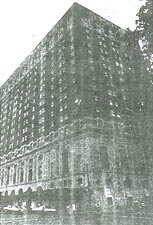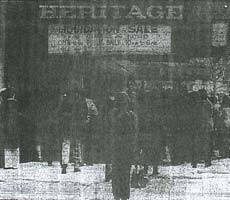|
|
 |
|
Hotel
sources claim that a bank draft of $10,000 has
arrived from Mohammad Faruk Kahn onboard a Pan
American World Airways flight. This money is to
be used to pay off the Heritage's utility bills
and get electric service turned back on. Detroit-Edison
denies receiving money or that power will be restored.
Adding
to the shuttered hotel's troubles are $139,923
in back taxes owed to the city. This includes
$110,323 in real estate taxes and $29,600 in personal
property tax from a two year period. The hotel
has a deadline of July 1, 1977 to pay off the
real estate taxes before the city threatens tax
foreclosure.
|
|
|
|
 |
|
 The
Heritage's closing has left $88.8 million worth
of convention hotel room bookings in peril. Fast
action on part of the Metropolitan Detroit Convention
and Visitors Bureau as well as the cooperation
of the Pontchartrain, Sheraton-Cadillac, Howard
Johnson's, and the Holiday Inn see that most of
this business is kept within the city. The
Heritage's closing has left $88.8 million worth
of convention hotel room bookings in peril. Fast
action on part of the Metropolitan Detroit Convention
and Visitors Bureau as well as the cooperation
of the Pontchartrain, Sheraton-Cadillac, Howard
Johnson's, and the Holiday Inn see that most of
this business is kept within the city.
As
for the Heritage, Leonard E. Rolston, president
of the MDCVB, says "It's too good a property
to sit idle."
Meanwhile,
William B. Waterman Jr, who claims to represent
a "big money" Las Vegas investment group
comes forward wishing to buy or lease the Heritage.
The group he calls Big Seven Inc. plans to convert
at least 50 percent of the hotel's rooms into
residences for university students. The remaining
500 rooms would remain hotel rooms. However, Waterman's
story doesn't hold as no evidence of the Big Seven
Inc. seems to exist nor does evidence of any of
the past projects Waterman cites.
|
|
|
|
 |
|
Mohommad
Faruk Kahn's deadline for completing the sale
of the Heritage passes with no deal. After weeks
of uncertainty the sale falls through.
|
|
|
|
 |
|
Seeking
cash with which to pay off the hotel's debts,
the Detroit Hilton Limited Partnership hires Content
Clearing & Exchange Crop. to sell off the
Heritage's contents. Everything from silverware,
beds, to paneling is up for sale.
 The
doors open at 10:00 a.m. January 1st and a flood
of bargain hunters descend on the hotel. Silverware
goes for 20 cents, mattresses for $5, $50 for
a complete bed, black and white televisions go
for $45, and lamps cost $20. Some more notable
items include $5 Statler Hilton dinner plates,
an Abe Lincoln plaque donated to the hotel in
1959 by the National Woman's Relief Corps sold
to Lincoln collector Art Goupel for $125, and
furnishings from Trader Vic's which go for $7,500. The
doors open at 10:00 a.m. January 1st and a flood
of bargain hunters descend on the hotel. Silverware
goes for 20 cents, mattresses for $5, $50 for
a complete bed, black and white televisions go
for $45, and lamps cost $20. Some more notable
items include $5 Statler Hilton dinner plates,
an Abe Lincoln plaque donated to the hotel in
1959 by the National Woman's Relief Corps sold
to Lincoln collector Art Goupel for $125, and
furnishings from Trader Vic's which go for $7,500.
The
Detroit-Cadillac Hotel purchases several items,
including lobby chandeliers.
Once
the small items are gone, paneling is removed
from several rooms and sold.
The
sale continues until the hotel is empty.
|
|
|
|
 |
|
With
$57,000 remaining in unpaid taxes the city files
suit to foreclose on the Heritage. The owners
are given 6 months to pay the money or face losing
the property.
Detroit
Hilton Limited Partnership attorney Fred Gordon
states that his group can come up with the money
but questions whether the property is worth the
taxes. A part owner of the site, Marjorie Fleming
states she is not responsible for any of the sum
due.
|
|
|
|
 |
|
The
City of Detroit acquires the Heritage following
a foreclosure action on back taxes. Total back
taxes at this point are estimated at $300,000.
Russell
Chambers, who handles real estate matters for
the Community and Economic Development Department
tells the Detroit Free Press that the Heritage
is in "very bad shape." Of the three
then closed downtown hotels, Heritage, Tuller,
and Fort Shelby, the Heritage is considered the
least likely to reopen. Observers state that it
was so heavily plundered during the liquidation
sale that it would cost to much to re-equip.
|
|
|
|
 |
| Despite
the negative observations Ann Arbor developer Richard
Berger proposes to transform the former Statler
into a hotel named 'Inn on the Park'. However, he
backs off and later states that he believes it would
not be cost effective to rehab the hotel. |
|
|
|
 |
|
Oakland
Co. developers Stanley Berger, Craig Smith, Richard
Lewiston, and Arnold and Walter Cohen announce
plans to convert the Statler into Le Gran Atrium,
a 300 unit apartment house.
Apartments
will range from studios of 700 square feet to
two-bedroom units. Rents are estimated at $350-$725
a month. Also included in the plans is a ground
floor restaurant and convenience store. The ballroom
floor will become a recreation center with game
and exercise rooms, a indoor swimming pool, and
a health club. The centerpiece will be a 14 story
atrium surrounded by open balconies and covered
with a skylight. Southfield architect Victor Shrem
designs the renovations.
The
project is estimated to cost $13 million. The
developers seek a federal Urban Development Action
Grant, property tax abatement, and national historic
designation for the building.
They
are hopeful work can start by October 1984.
|
|
|
|
 |
|
The
Michigan State Housing Development Authority approves
a $9.6 million loan for the redevelopment of the
Statler into the Le Gran Atrium. However, unforeseen
cost have driven the pricetag of the project to
$16.3 million. Stanley Berger plans to request
an additional $1 million from the MSHDA.
Meanwhile,
the group seeks a $2.5 million Urban Development
Action Grant through HUD. To receive HUD money,
at least 20% of the apartments must be available
for low income housing.
Berger
states that the remaining $3.2 million will come
from private investment.
|
|
|
|
 |
| The
Statler renovation project is one of two in Detroit
that HUD awards grants to. HUD provides $2.5 million. |
|
|
|
 |
|
The
renovation of the Statler is threatened by proposed
changes to the federal tax credit program. If
the tax credits are eliminated Stanley Berger
says "That would stop our project".
The
price of renovation rises again. Now it is estimated
to cost $18 million.
|
|
|
|
 |
|
The
price of the renovation again skyrockets. A 400
car parking structure is added to the package
which raises the total cost to $25 million. Likewise,
the Michigan State Housing Development Authority's
stake rises to $19 million from $9.6 million.
Additional
changes include a raise in rents to $395 to $1500
a month. Some apartments will be three stories
tall and 14 will be handicapped accessible.
Construction
is slated to begin by year's end.
|
|
|
|
 |
|
Work
has still not begun on the renovation of the Statler.
The
Detroit City Council considers to pump $80 million
into several major downtown renovation projects.
The Statler project is slated to receive $3 million
of that.
|
|
|
|
 |
|
After
4 years of delays the development team behind
the renovation of the Statler announces they have
finally secured all the financing and are set
to begin construction in the summer.
The
project is now termed Atrium Place and will include
334 apartments renting from $495 to $1500 a month.
However,
the financing fails to fall into place as hoped.
***
Since this is the last mention I have found of
this group's efforts, I assume the Atrium Place
project died at this point. ***
|
|
|
|
 |
|
 With
the North American International Auto Show coming
to town in January, the Statler and other vacant
buildings of Grand Circus Park present an image
problem for the city. Riders of the People Mover
are treated to grim views of decay. Not wanting
out-of-towners, and especially journalist to see
this, the Detroit Downtown Development Authority
spends $70,000 to install new awnings and window
coverings on the Statler and neighboring structures. With
the North American International Auto Show coming
to town in January, the Statler and other vacant
buildings of Grand Circus Park present an image
problem for the city. Riders of the People Mover
are treated to grim views of decay. Not wanting
out-of-towners, and especially journalist to see
this, the Detroit Downtown Development Authority
spends $70,000 to install new awnings and window
coverings on the Statler and neighboring structures.
These
awnings help with appearances but over the years
they fade and tatter. Ultimately they worsen the
image of the area.
|
|
|
|
 |
| The
Statler faces the threat of demolition as both Donald
Trump and Don Barden seek to use the site for proposed
casinos. Both casino applicants are denied and no
other group selects the Washington Blvd. location. |
|
|
|
 |
| At
the request of the city, the Greater Downtown Partnership
holds Request For Proposals for the Statler and
nearby Kales Building. The Statler is offered for
$100,000 'as is'. The terms are either the hotel's
renovation or demolition and replacement by a comparable
structure. Bids are due August 6. |
|
|
|
 |
| A
$2.5 million state funded cleanup of the Statler
site begins. Water which had flooded the basement
is removed. |
|
|
|
 |
| Work
progresses on selecting between the RFP bidders
and cleaning the site. |
|
|
| Copyright
2001, David Kohrman |
Last
updated on 11-14-01
|
|
|